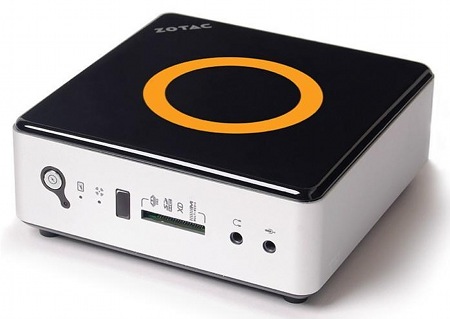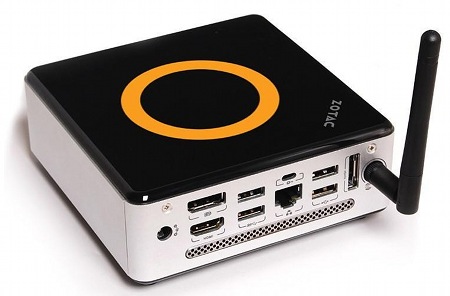Tiny home theater PC has dual-core Via CPU, IR remote
Oct 14, 2011 — by LinuxDevices Staff — from the LinuxDevices Archive — 15 viewsZotac announced a mini-PC built around Via's 1.2GHz, dual-core Nano X2 U4025 processor. The 5 x 5 x 1.7-inch Zbox Nano VD01 includes 802.11b/g/n and Bluetooth networking, HDMI and DisplayPort video outputs, 7:1 audio, an infrared remote and receiver, plus an available 2GB of RAM and 320GB of hard disk storage.
More than any other vendor we can think of, Zotac plays the field when it comes to selecting CPUs and supporting chipsets. Its "Zbox" mini-PCs have employed: Intel Atom processors, with or without Nvidia graphics processing units; Intel Celerons; AMD Athlon Neo X2s; and, most recently, AMD's dual-core, 1.6GHz E-350.
In fact, Zotac featured the E-350 both in the ADO3 — featuring an integral, slot-loading optical drive — it announced last January, and in the Nano AD10 it released last month. The latter is a home theater-oriented, 5.0 x 5.0 x 1.7-inch box supplied with an internal infrared receiver, a supplemental USB-based infrared receiver.
Now, we have the new Nano VD01, employing the same case as the Nano AD10. Pricing wasn't announced, but presumably the VD01 is intended to offer essentially the same features as the AD10, but at an entry-level price. It turns to Via's dual-core, 1.2GHz Nano X2 U4025 and the VX900 companion chip.

Zotac's Zbox Nano VD01 (front)
(Click to enlarge)
We're sure these components can't match the performance of the AMD E-350/A50M chipset, but HD video playback and Blu-ray decoding are still claimed for the VD01. Retaining the remote control facilities of the AD10, the VD01 provides 7:1 audio via HDMI or S/PDIF outputs, Zotac adds.
According to Zotac, the VD01 is offered either in a barebones configuration, or in a "Plus" version (fitted with with 2GB of RAM in its single DIMM slot and a 320GB hard disk in its 2.5 drive bay). Either way, operating system installation is apparently up to the user.
Meanwhile, the VD01's front panel (pictured earlier above) includes a SD/SDHC/MS/MS Pro/xD/MMC card reader, a microphone input, a headphone jack, and an IR port. The rear panel (below) includes DisplayPort and HDMI video outputs, two USB 3.0 ports, two USB 2.0 ports, an eSATA port, and an antenna connector, according to Zotac.

Zotac's Zbox Nano VD01 (rear)
(Click to enlarge)
Carsten Berger, marketing director for Zotac International, stated, "Zotac is pleased to expand its mini-PC lineup with the addition of a Via platform. The Via Nano X2 with with VX900H chipset enables us to deliver an affordable energy-efficient mini-PC that is ideal for digital media consumption and home server use."
Specifications listed by Zotac for the Zbox Nano VD01 and VD01 Plus include:
- Processor — Via Nano X2 U4025 (dual-core, 1.2GHz)
- Chipset — Via VX900
- Memory — single SODIMM slot; VD01 Plus model bundles 2GB of DDR3 RAM
- Storage:
- 6-in-1 memory card reader (SD/SDHC/MS/MS Pro/xD/MMC)
- 2.5-inch drive bay, supporting 3.0 Gb/sec. SATA devices; VD01 Plus adds 320GB drive
- Networking — gigabit Ethernet
- Wireless:
- 802.11b/g/n with antenna
- Bluetooth 3.0
- onboard IR receiver with remote
- USB IR receiver
- Other I/O:
- eSATA port
- 2 x USB 3.0
- 2 x USB 2.0
- HDMI
- DisplayPort
- audio — mic in, headphone out, S/PDIF out
- Power — 19VDC via bundled AC adapter
- Dimensions — 5.0 x 5.0 x 1.7 inches
Further information
No pricing or availability information was provided for the Zbox Nano VD01, but it appears to be close to shipping. More information may be found at the Zotac Zbox Nano VD01 and Zbox Nano VD01 Plus product pages.
Jonathan Angel can be reached at [email protected] and followed at www.twitter.com/gadgetsense.
This article was originally published on LinuxDevices.com and has been donated to the open source community by QuinStreet Inc. Please visit LinuxToday.com for up-to-date news and articles about Linux and open source.